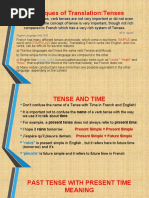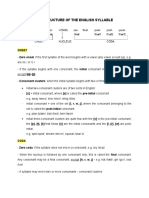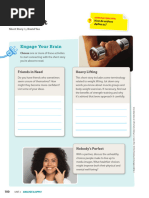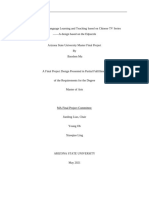Unit 5a: English Plosives /P B, T D, K Ɡ, ?/: Table: Three Part Description of The Consonant Phonemes in English
Unit 5a: English Plosives /P B, T D, K Ɡ, ?/: Table: Three Part Description of The Consonant Phonemes in English
Uploaded by
Thanh TrầnCopyright:
Available Formats
Unit 5a: English Plosives /P B, T D, K Ɡ, ?/: Table: Three Part Description of The Consonant Phonemes in English
Unit 5a: English Plosives /P B, T D, K Ɡ, ?/: Table: Three Part Description of The Consonant Phonemes in English
Uploaded by
Thanh TrầnOriginal Title
Copyright
Available Formats
Share this document
Did you find this document useful?
Is this content inappropriate?
Copyright:
Available Formats
Unit 5a: English Plosives /P B, T D, K Ɡ, ?/: Table: Three Part Description of The Consonant Phonemes in English
Unit 5a: English Plosives /P B, T D, K Ɡ, ?/: Table: Three Part Description of The Consonant Phonemes in English
Uploaded by
Thanh TrầnCopyright:
Available Formats
Unit 5a: English Plosives /p b, t d, k ɡ, ?
/
When the vocal folds slightly open to vibrate and the sound is obstructed at the vocal
cavity, the sound is described as the voiced consonant sound.
When the folds are widely open to vibrate and the sound is obstructed at the vocal tract,
the sound is described as voiceless consonant. Another term used to describe
voiced/voiceless sounds are fortis/lenis.
Table: Three part description of the consonant phonemes in English
Place Bi- Labio- Dental Alveolar Palato- Palatal Velar Glottal
labial dental alveolar
Manner
Plosive
p b t d k g ?
Fricative
f v θ ð s z ∫ ʒ h
Affricate
t∫ ʤ
Nasal
m n ŋ
Lateral
l
Liquid
r
Semi-vowel
w j
In the pairs of sounds to be discussed, the left hand consonants are voiceless and fortis
while the right ones are voiced and lenis.
1 INTRODUCTION
This unit describes the sounds referred to as plosive sounds. They are also often referred
to as stops.
2 OBJECTIVES
At the end of the unit, learners will be able to identify and describe the English plosive
sounds and pronounce them correctly.
3.1 /p b/: Bilabial Plosive
/p/ is voiceless and fortis while /b/ is voiced and lenis. In the production of these
sounds, the air that escapes through the glottis into the oral cavity is obstructed or
stopped by the upper and lower lips. This obstruction forces the air to build up pressure
inside the mouth that when the two lips part to allow it flow out, it causes some kind of
explosive sound.
Apart from being plosives, the two sounds are also described as bilabials because the
two lips are the major articulators during their production.
/p/ occurs as: p, pp, gh as in: pile, cripple, hiccough;
when aspirated: pin, pill, pass, important, people;
when unaspirated: Spain, spite, split;
when silent: pneumonia, psychology;
when initial; medial; final: pen, Paul; staple stipend; tap, cheap.
/b/ occurs as: b, bb as in: bile, bubble;
when initial; medial; final: boot, bite; about, laborious; tab, tube.
3.2 /t d/: Alveolar Plosive
The voiceless-fortis/voiced-lenis divisions are still applicable here. But in addition, the
tip of the tongue clicks at the alveolar and allows the pent up air to escape with an
explosion. They are, therefore, plosive sounds.
/t/ occurs as: t, tt, d, th as in: tell, little, asked, Thailand and Thompson;
when aspirated: take, tall, tight;
when unaspirated: tick, tool, letter;
when initial: tie, ten; medial: latter, written; final: sat, mat.
/d/ occurs as d, dd as in: do, idle, add, ladder;
when initial: die, den; medial: ladder ridden, ; final: sad, pad.
3.3 /k ɡ/: Velar Plosive
The voiceless-fortis/voiced-lenis characteristics also hold. In addition, the back of the
tongue strikes the velar i.e. the soft palate. While doing this, the two organs (tongue and
velar), which once stuck together and barred air from flowing out suddenly part ways
allowing a rush out of air with a plosive sound.
/k/ occurs as: k, c, cc, ch as in: kind, cut, accord, chord;
when aspirated: kind, cat car; when unaspirated: sky, skill, scar;
when initial: kiss, call, medial: actual, akin final tick, park.
/g/ occurs as: g, gg as in: gas, gut, maggot, biggest;
when initial: gas, give, medial: ago, bigger; final: pig, leg, peg.
3.4 /?/: Glottal Plosive
This sound is not a significant consonant sound in RP but very popularly used across the
London streets; it is produced at the glottal region of the oral tract. It’s a sound which
now seems to have replaced the voiceless, fortis, alveolar plosive, /t/ in Poplar London
variety of English. It is a voiceless, fortis, glottal sound, which occurs in words such as
water, butter, but pronounced as /wɒ?ә/ and /bʌ?ә/ instead of / wɒtә/ and /bʌtә/. It is
because /?/ is a variety of sound used among the native speakers in London that is why
it is not common to us.
4 EXERCISES
With the aid of 5 examples each, what do you understand by these terms, fortis and
lenis? Use English words and sounds as examples.
You might also like
- Market Leader Intermediate Unit Test 8Document4 pagesMarket Leader Intermediate Unit Test 8Sonia Del Val CasasNo ratings yet
- Phonetics (First Year English) Guerfi HindDocument28 pagesPhonetics (First Year English) Guerfi HindAlla L'GameurNo ratings yet
- Chapter 16 - 17 Group 7Document37 pagesChapter 16 - 17 Group 7Thúy ViNo ratings yet
- Exercises and NotesDocument36 pagesExercises and Notesqmbhb458yhNo ratings yet
- Chapter 15 Gestures and Sign Languages: The Study of Language, 5 Edition George YuleDocument8 pagesChapter 15 Gestures and Sign Languages: The Study of Language, 5 Edition George Yulesovanrat KhievNo ratings yet
- Language HistoryDocument38 pagesLanguage Historysayed shahabuddin AdeebNo ratings yet
- Strong and Weak SyllablesDocument22 pagesStrong and Weak SyllablesCarolina QuinteroNo ratings yet
- Word Stress in EnglishDocument6 pagesWord Stress in EnglishHafid Tlemcen Rossignol PoèteNo ratings yet
- Introduction To LinguisticsDocument5 pagesIntroduction To LinguisticsIna BaraclanNo ratings yet
- Exercises 2023Document4 pagesExercises 2023Huỳnh Thư Nguyễn LêNo ratings yet
- English Phonetics and PhonologyDocument68 pagesEnglish Phonetics and PhonologyẾch Kêu EmNo ratings yet
- English Phonetics and Phonology - Peter Roach 211 243Document33 pagesEnglish Phonetics and Phonology - Peter Roach 211 243Thị Hồng Nhung PhạmNo ratings yet
- Yule SyntaxDocument10 pagesYule SyntaxquincydegraciNo ratings yet
- Introductory Lectures To The English Phonetics and PhonologyDocument9 pagesIntroductory Lectures To The English Phonetics and PhonologyKhawla AdnanNo ratings yet
- 8 The SyllableDocument8 pages8 The SyllableCattNo ratings yet
- Unit 2 - Long VowelsDocument15 pagesUnit 2 - Long VowelsalexNo ratings yet
- Chapter One: The English SoundsDocument7 pagesChapter One: The English SoundsGodson Patrick100% (1)
- WEEK 7 - Strong and Weak SyllablesDocument20 pagesWEEK 7 - Strong and Weak SyllablesVũ Thành LộcNo ratings yet
- An Introductory English Grammar - Chapter 9Document13 pagesAn Introductory English Grammar - Chapter 9Dr.Eman LinguisticsNo ratings yet
- Chapter 3 - PhonologyDocument44 pagesChapter 3 - PhonologyMinh Thành NguyễnNo ratings yet
- Summary About The Study of Language CH 12&13&14Document14 pagesSummary About The Study of Language CH 12&13&14somamohamed arafaNo ratings yet
- Exercises On Transcription 1Document4 pagesExercises On Transcription 1Manuel Rangel100% (1)
- The Consonants - Fricatives - AffricatesDocument10 pagesThe Consonants - Fricatives - AffricatesThục UyênNo ratings yet
- Chapter 13 - First Language AcquisitionDocument21 pagesChapter 13 - First Language Acquisitionhalla100% (1)
- EPP - Rhythm and AssimilationDocument14 pagesEPP - Rhythm and AssimilationVirdha DhewiNo ratings yet
- Techniques of Translation (Tenses)Document25 pagesTechniques of Translation (Tenses)Hania TibaryNo ratings yet
- Chapter 6 MorphologyDocument19 pagesChapter 6 MorphologyNghi PhuongNo ratings yet
- CHAPTER 15 GESTURES AND SIGN LANGUAGESDocument19 pagesCHAPTER 15 GESTURES AND SIGN LANGUAGESGizem MichaelisNo ratings yet
- Chapter 2 - Morphology LectureDocument15 pagesChapter 2 - Morphology LectureShy PaguiganNo ratings yet
- Syntax by Dororo HyakimaruDocument28 pagesSyntax by Dororo HyakimaruJamyla LaouejNo ratings yet
- College EnglishDocument7 pagesCollege EnglishYanyan OrozcoNo ratings yet
- Word FormationDocument6 pagesWord FormationCherish Pimmaeng100% (1)
- Are You in The Right Place?Document164 pagesAre You in The Right Place?galuh pfNo ratings yet
- Connected SpeechDocument4 pagesConnected SpeechMaría CarolinaNo ratings yet
- Chapter IV The SyllableDocument3 pagesChapter IV The SyllableMinh LiểuNo ratings yet
- Phonetics and PhonologyDocument3 pagesPhonetics and PhonologySad CypressNo ratings yet
- First Language AcquisitionDocument32 pagesFirst Language AcquisitionNadia SimónNo ratings yet
- Chapter TwoDocument4 pagesChapter TwoIris NguyễnNo ratings yet
- Global Advanced-Unit-6 Student BookDocument12 pagesGlobal Advanced-Unit-6 Student BookPao100% (1)
- Introduction To Linguistics: Final Exam Practice Questions: Tnagano@gc - Cuny.eduDocument13 pagesIntroduction To Linguistics: Final Exam Practice Questions: Tnagano@gc - Cuny.eduEvangeline TorremochaNo ratings yet
- Lexicography All The LecturesDocument21 pagesLexicography All The Lecturesomarsattam511No ratings yet
- The Structure of The English SyllableDocument3 pagesThe Structure of The English SyllableHyRi NguyễnNo ratings yet
- Awang FH Morpho SyntaxDocument4 pagesAwang FH Morpho SyntaxmaukimaukiNo ratings yet
- Adjectives and Adverbs in EnglishDocument31 pagesAdjectives and Adverbs in EnglishNayeNo ratings yet
- اللغة الانكليزية تحليلات 2Document88 pagesاللغة الانكليزية تحليلات 2ss0857003No ratings yet
- Vowel ArticulationDocument6 pagesVowel ArticulationMasrudin LasitamuNo ratings yet
- Workbook 1-10 (Answered)Document100 pagesWorkbook 1-10 (Answered)aya mmooNo ratings yet
- Sociolinguistics Notes 1Document11 pagesSociolinguistics Notes 1api-701190381No ratings yet
- English Phonetics and Phonology: Peter RoachDocument13 pagesEnglish Phonetics and Phonology: Peter RoachzahraNo ratings yet
- CH 1, Studying MeaningDocument44 pagesCH 1, Studying MeaningTaif Alzahrani0% (1)
- Plosives, Fricatives and AffricatesDocument3 pagesPlosives, Fricatives and Affricatesmartina cortezNo ratings yet
- Morphology, Part 1Document4 pagesMorphology, Part 1Ian BlankNo ratings yet
- Aspects of Connected SpeechDocument7 pagesAspects of Connected SpeechJolyn LongNo ratings yet
- Worksheet 1 - Linguistics Eng B: The Origins of Language, Animals and Human Language, and Word FormationDocument3 pagesWorksheet 1 - Linguistics Eng B: The Origins of Language, Animals and Human Language, and Word FormationAbdulrahman Abdullah SaifNo ratings yet
- Chapter 4 - SEMANTIC RELATIONSDocument65 pagesChapter 4 - SEMANTIC RELATIONSHan TranNo ratings yet
- Phonetics: The Scientific Study of Speech SoundsDocument35 pagesPhonetics: The Scientific Study of Speech SoundsSam Ng100% (1)
- Semantic FeaturesDocument6 pagesSemantic FeaturesMarsuki GaniNo ratings yet
- Phoneme: The Smallest Sound Unit That Serves ToDocument15 pagesPhoneme: The Smallest Sound Unit That Serves ToHilbeen DoskyNo ratings yet
- Linguistic Review SyntaxDocument3 pagesLinguistic Review SyntaxJoanneNo ratings yet
- U5b English Affricates FricativesDocument3 pagesU5b English Affricates FricativesMuhammad Asif KhanNo ratings yet
- On Tap Unit 4 5 Anh 9Document8 pagesOn Tap Unit 4 5 Anh 9Thanh TrầnNo ratings yet
- Ôn Thi Giũa K I 2021Document9 pagesÔn Thi Giũa K I 2021Thanh TrầnNo ratings yet
- Tài liệuDocument1 pageTài liệuThanh TrầnNo ratings yet
- Kiem Tra gk1Document5 pagesKiem Tra gk1Thanh TrầnNo ratings yet
- Homework: Give Your Answers QUESTION 1 Underline The Correct AnswerDocument9 pagesHomework: Give Your Answers QUESTION 1 Underline The Correct Answeranaly0% (1)
- Instant Access to The Crosscultural, Language, and Academic Development Handbook: A Complete K 12 Reference Guide 6th Edition, (Ebook PDF) ebook Full ChaptersDocument51 pagesInstant Access to The Crosscultural, Language, and Academic Development Handbook: A Complete K 12 Reference Guide 6th Edition, (Ebook PDF) ebook Full Chaptersakdimlesson100% (2)
- Module in Purposive Communication 3Document16 pagesModule in Purposive Communication 3Karyl Peñaflor - GurayNo ratings yet
- NUR-514 Rubric - The Evolution of Nursing Informatics PresentationDocument2 pagesNUR-514 Rubric - The Evolution of Nursing Informatics PresentationWekesa EvansNo ratings yet
- 2 Seminar. TCALDocument19 pages2 Seminar. TCALBohdana MysanetsNo ratings yet
- Hany Fathy: Mobile: +201028090701 E-MailDocument2 pagesHany Fathy: Mobile: +201028090701 E-MailHany Fathy AbdelnaeimNo ratings yet
- Mcm301 Grand Quiz by JunaidDocument12 pagesMcm301 Grand Quiz by Junaidsabiha kamranNo ratings yet
- (eBook PDF) Teaching English Language and Content in Mainstream Classes: One Class, Many Paths 2nd Edition download pdfDocument56 pages(eBook PDF) Teaching English Language and Content in Mainstream Classes: One Class, Many Paths 2nd Edition download pdfzineebbojkic100% (6)
- IELTSDocument11 pagesIELTSrewertsdimegliozx.zj8.69.4No ratings yet
- Cambridge English Preliminary For Schools Teachers Handbook 32 40Document9 pagesCambridge English Preliminary For Schools Teachers Handbook 32 40Nấm HươngNo ratings yet
- American Passages 01 - A Literary Survey - Native VoicesDocument50 pagesAmerican Passages 01 - A Literary Survey - Native VoicesDima AbdulNo ratings yet
- Un-Instagramable Self SpacecatDocument3 pagesUn-Instagramable Self Spacecatapi-528651903No ratings yet
- Messages 3 Student's BookDocument32 pagesMessages 3 Student's BookHristina Ristevska JoshevskaNo ratings yet
- Олимпиады Гулов 7-8 классDocument39 pagesОлимпиады Гулов 7-8 классjuliyabondNo ratings yet
- So, Too, Neither, EitherDocument13 pagesSo, Too, Neither, EitherAlexander Lace TelloNo ratings yet
- Heartbeat LNDocument12 pagesHeartbeat LNdkspfv7vq5No ratings yet
- Grammar - 1-ADocument7 pagesGrammar - 1-AB20L7-Choun Vey -Gram & WriteNo ratings yet
- Sakartvelo Pro / enDocument1 pageSakartvelo Pro / enCNPNo ratings yet
- Test PaperDocument3 pagesTest Papertarun18789maths0% (1)
- Presentation: Where Is/are ... ?: Prepositions of Place (In, On, Next To, Under)Document2 pagesPresentation: Where Is/are ... ?: Prepositions of Place (In, On, Next To, Under)Leila Duran GaviriaNo ratings yet
- Bài tập về Danh từ da chuaDocument6 pagesBài tập về Danh từ da chuaHoài NgọcNo ratings yet
- Chapter 1Document8 pagesChapter 1orouba byuNo ratings yet
- Grade 1Document14 pagesGrade 1sukumar sidduNo ratings yet
- English All You Need To Know About Live Language Learning With BusuuDocument9 pagesEnglish All You Need To Know About Live Language Learning With BusuuGizem BaştürkNo ratings yet
- Types of Speech DeliveryDocument2 pagesTypes of Speech DeliveryBensonNo ratings yet
- Master Final Project by BaoshenDocument24 pagesMaster Final Project by BaoshenbaoshenmNo ratings yet
- Ordinary - English As A Second Language Paper 2 6109-2 - First Proof 14.03.2023Document8 pagesOrdinary - English As A Second Language Paper 2 6109-2 - First Proof 14.03.2023josefinaamadhila13No ratings yet
- Contoh Kalimat If Clause Imperative Dan ArtinyaDocument13 pagesContoh Kalimat If Clause Imperative Dan ArtinyaHafizatus SofaNo ratings yet
- Can and Could: Grammar WorksheetDocument2 pagesCan and Could: Grammar WorksheetEdison Mamani0% (1)





























































































